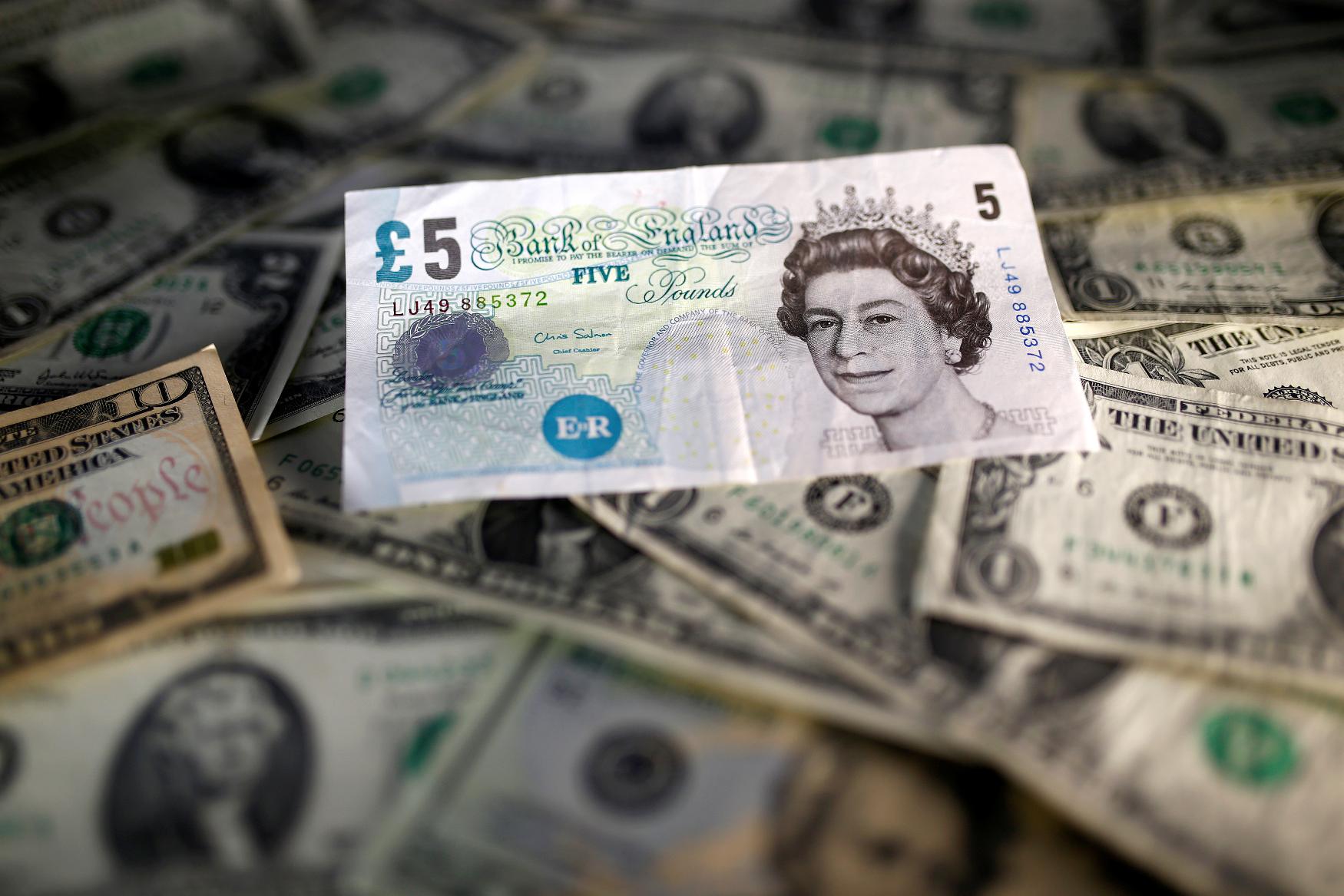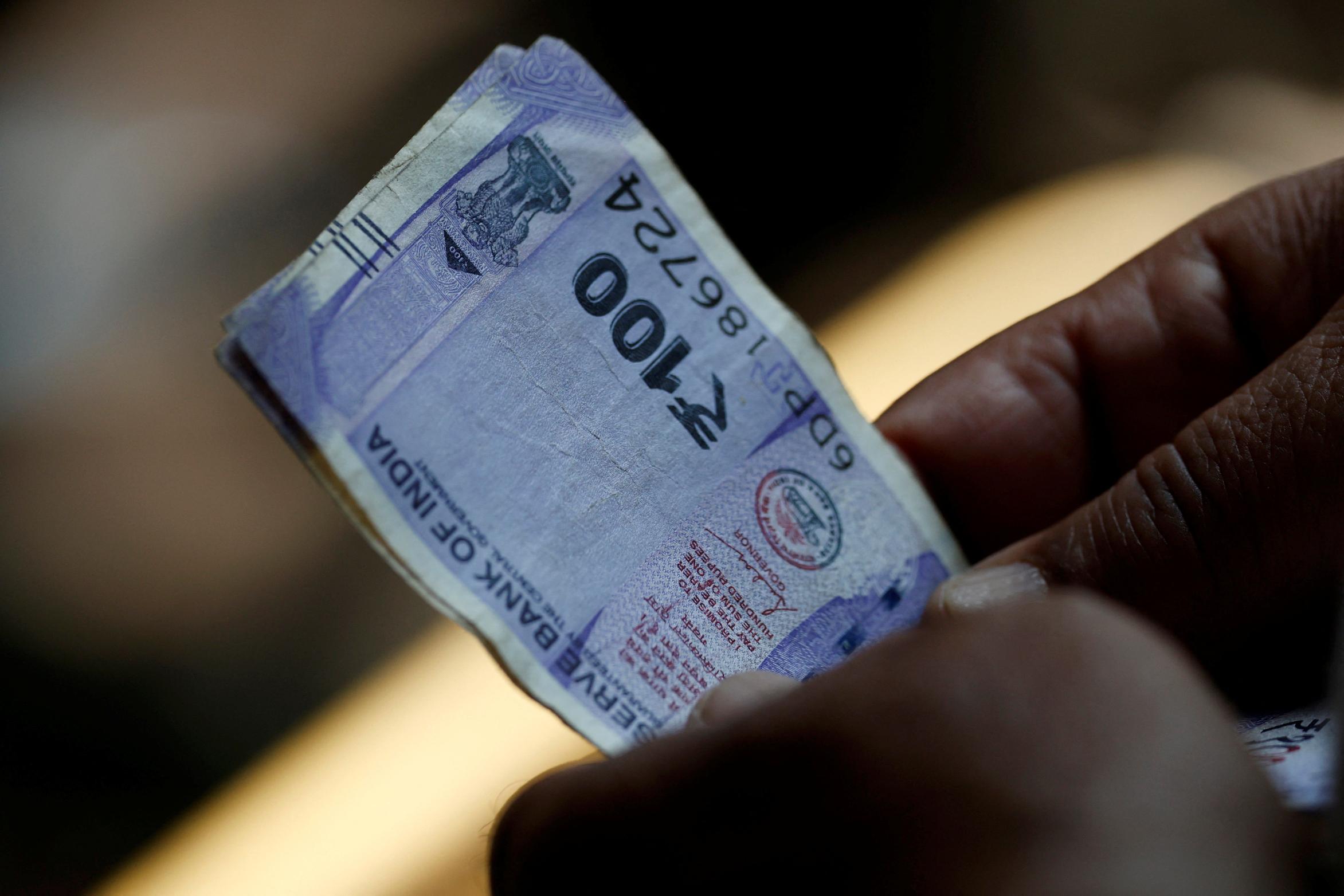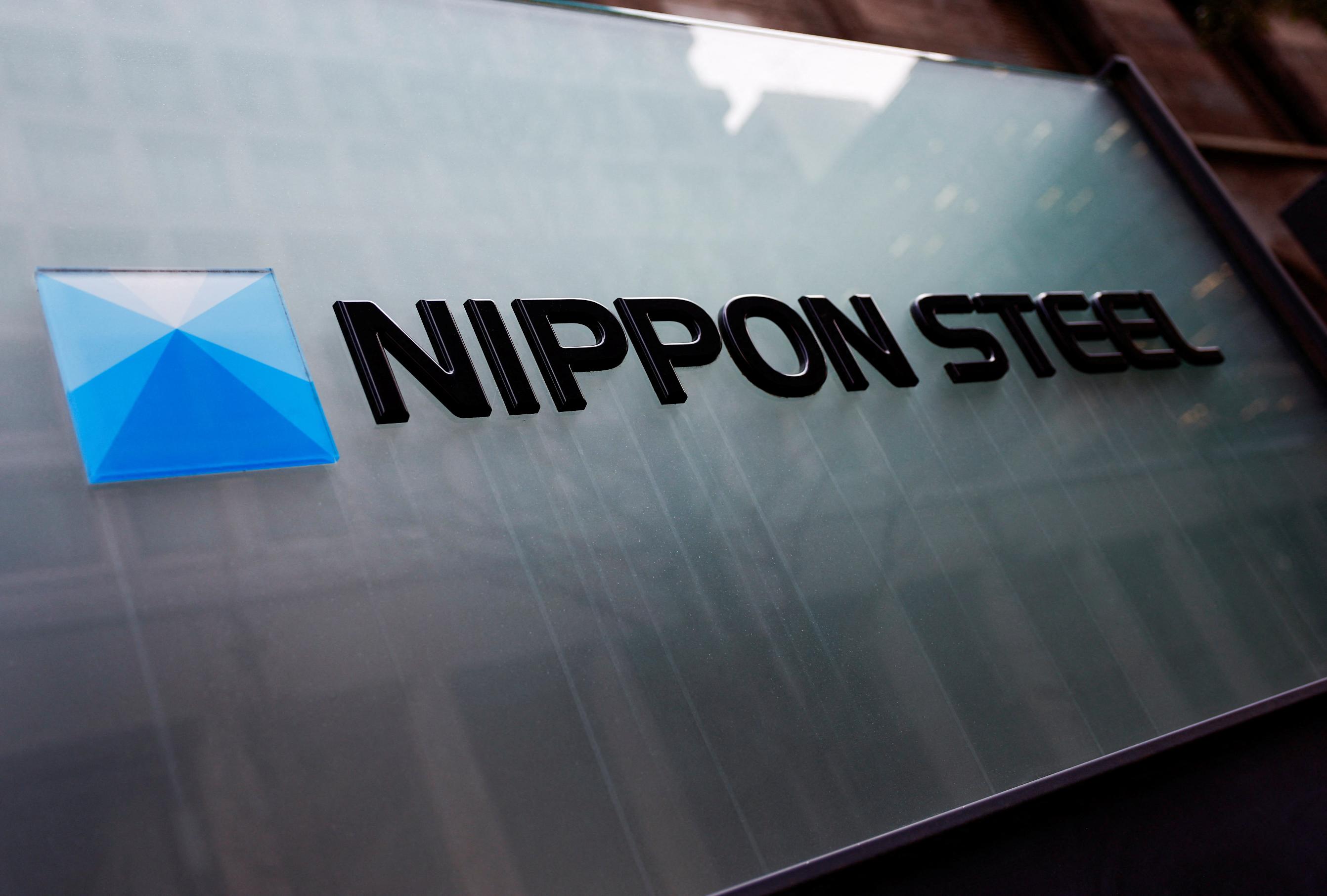
2024-09-20 10:36
Sept 20 (Reuters) - Sterling edged up against the dollar and the euro on Friday, as strong UK retail sale data provided an extra boost to the currency's upbeat trend. The pound briefly hit $1.33405, touching March 2022 highs for the third consecutive day, but pared earlier gains to $1.32975 . It gained 1.23% on the week. Nordea Bank chief analyst Niels Christensen pointed to a strong UK retail sales report on Friday, as well as this week's inflation data and Bank of England rate decision, as reasons for the upward trend. British retail sales rose by a stronger-than-expected 1% in August and growth in July was revised up, official figures showed. Looking ahead, data for Britain is "not that soft" and rate cut expectation has moved a further out in the future, Christensen added. "That's also a reason why we see a stronger sterling, not only against the yen, but also against the dollar, and also against the euro," he said. The euro fell 0.10% to 83.97 pence , recovering slightly from an earlier drop to its lowest level in two years. Sterling had risen on Wednesday as data showed that British inflation held steady in August but rose in the services sector, which is closely watched by the BoE, to 5.6% from 5.2% in July. It got a further boost after a cautious BoE kept interest rates at 5.0% on Thursday, with its rate setter Catherine Mann saying earlier on Friday that she took a guarded view on the prospect of multiple rate cuts in the months ahead and stressing the need for policy to remain restrictive. Money markets priced in a 71% chance of a 25 basis points rate cut from the BoE on its next meeting in November. The pound rose 0.90% versus the yen at 191.16, as the yen weakened after Bank of Japan's governor steered clear of rate hike talk following the BoJ's decision to hold interest rates. "A softer yen just makes sterling firmer across the board," Christensen said. Sign up here. https://www.reuters.com/markets/currencies/sterling-rises-vs-dollar-euro-boosted-by-strong-uk-retail-sale-data-2024-09-20/

2024-09-20 10:14
MUMBAI, Sept 20 (Reuters) - The Indian rupee rose for the fifth straight session on Friday, helped by gains in Asian peers and likely portfolio inflows, after the U.S. Federal Reserve kicked off its interest rate cutting cycle earlier this week. The rupee closed at 83.5625 against the U.S. dollar, up from its close at 83.68 in the previous session. The Indian currency jumped to an more than two-month high of 83.4850 earlier in the session and gained nearly 0.4% week-on-week, its strongest weekly rise this year. The Fed's larger-than-usual 50-basis-point rate cut on Wednesday, and inflows into local stocks and bonds have lifted the rupee, traders said. Overseas investors have net bought more than $7 billion of Indian debt and equities so far in September, the highest monthly inflow since December 2023. Benchmark Indian equity indices, the BSE Sensex and the Nifty 50, rose to record highs on Friday and ended the day up about 1.5% each. Inflows were "quite strong" but the rupee gave up some gains after dollar bids from state-run banks picked up, a trader at a foreign bank said. The dollar index was up nearly 0.1% at 100.8, while most Asian currencies rose between 0.1% and 0.6%. The offshore Chinese yuan , a closely watched peer currency of the rupee, rose to a 16-month peak of 7.04. Investors are currently pricing in another 70 basis points of rate cuts by the Fed over 2024, implying that one of the central bank's remaining two policy decisions this year is likely to be another 50-bp cut. Odds of a 50-bp rate cut in November are currently at 44%, according to CME's FedWatch tool. Societe Generale's FX strategists expect a secular decline in the dollar over the coming quarters, according to a note. Sign up here. https://www.reuters.com/markets/currencies/rupee-logs-best-week-this-year-aided-by-fed-cut-portfolio-inflows-2024-09-20/

2024-09-20 10:02
A look at the day ahead in U.S. and global markets from Mike Dolan After a roaring Thursday that saw Wall Street stocks lap up deep Federal Reserve easing into a still-healthy economy, there's a modest step back today and an eye on other central banks choosing to stand pat for now. Going in different directions to each other policy-wise, central banks in Japan and China choose to hold the line on their interest rates on Friday - the latter slightly surprisingly given the alarming deceleration of its economy. The People's Bank of China unexpectedly left lending rates unchanged at monthly fixings, confounding forecasts after the outsize 50 basis point Fed cut on Wednesday. Almost 70% of market participants polled earlier in the week had seen a cut. Whether that's just a delay to synch up with broader stimulus plans later is a moot point, but - perhaps unhelpfully for China - it's lifted the offshore yuan to a new 16-month high. Less surprisingly, the Bank of Japan left policy settings unchanged on Friday too - holding back from further tightening for now even as it upgraded its economic assessment and core consumer inflation ticked up to 2.8% in August as expected. With BOJ officials seemingly unrushed in further 'normalisation' of ultra-low rates, the yen weakened back to near 144 per dollar. In Europe on Thursday, the Bank of England - with one eye on the new Labour government's first budget next month - also held back from making its second rate cut of the year. And that lifted sterling to its best levels since March 2022. The UK backdrop to both the BoE decision and the budget was mixed - with falling consumer confidence at a six-month low, even though rising August retail sales beat forecasts. The fiscal picture darkened, however, with news of bigger public borrowing last month than, expected and government debt at 100% of GDP for the first time since comparable records began 31 years ago. Back on Wall Street, it was still largely a case of 'what's not to like?' for investors. The big Fed cut alongside news of falling weekly jobless puts the 'soft landing' firmly on track and all stock indexes surged on Thursday - with new record highs for the S&P500 (.SPX) , opens new tab and the equal-weighted version of the index (.EWGSPC) , opens new tab that adjusts for the handful of megacap leaders. Both the tech-heavy Nasdaq (.IXIC) , opens new tab and small cap Russell 2000 (.RUT) , opens new tab hit their best levels since July. The S&P500 and Nasdaq are now both up 20% for the year so far. The VIX volatility gauge (.VIX) , opens new tab subsided under 17 and below long-term averages. Fed futures, which price slightly more easing over the remainder of this year than the additional 50bps indicated by the central bank, now see 200bps of cuts over the coming 12 months, to settle at 2.9% - where the Fed has indicated its long-term 'neutral' rate now lies. U.S. Treasuries seem comfortable with that - with 2-year Treasury yields hovering near 2-year lows under 3.6% and the newly positive 2-to-10 year yield curve gap above 10bps for the first time in more than two years. As to whether the Fed is easing too much, inflation expectations have ticked up a bit but remain just above the Fed's 2% target. Crude oil prices have edged higher this week, not least due to renewed Middle East tension, but rolling year-on-year oil price losses have now been running at more than 20% for two weeks solid. With attention on the other central banks, the dollar index (.DXY) , opens new tab firmed up a tad from the year's lows. Stock futures were off a touch from new records before Friday's bell. The focus now probably shifts to a raft of Fed officials on the stump over the coming week - and they may shine further light into the thinking around this week's big rate cut. Quarter-end also comes into view and, of course, the November election campaign starts to heat up. Latest polling has the two main presidential candidates roughly tied nationally, though Democrat Kamala Harris remains slight favourite in betting markets. Key developments that should provide more direction to U.S. markets later on Friday: * Euro zone September consumer confidence; Canada August producer prices * Philadelphia Federal Reserve President Patrick Harker speaks; European Central Bank President Christine Lagarde and International Monetary Fund Managing Director Kristalina Georgieva speak in Washington; Bank of Canada Governor Tiff Macklem speaks; Bank of England policymaker Catherine Mann and BoE Executive Director David Bailey speak Sign up here. https://www.reuters.com/markets/us/global-markets-view-usa-2024-09-20/

2024-09-20 07:50
WROCLAW, Poland, Sept 20 (Reuters) - A social media producer whose accounts would normally show people where to eat out and relax in the historic Polish city of Wroclaw has shifted his focus to showing people where they can volunteer to protect the city against flood waters. Central Europe has been ravaged by floods that have caused billions of dollars of damage and killed at least 24 people, but Poland's third largest city has escaped the worst of the damage, in part thanks to a huge mobilisation of members of the public who have worked round the clock building walls of sandbags. "We have changed our approach a little bit at the moment due to the fact that we actually have the biggest reach in Wroclaw now, because we are followed by almost 600,000 people on social media, Instagram and Facebook," said 35-year-old social media producer Kamil Karpinski. Through social media profiles like Karpinski's, people offer tools, resources, transportation and their own time. One such person is Patrycja Rozmus, a 26-year-old IT recruiter, who took a day off to help tie bags of sand under the Tarczynski Arena stadium. "People are afraid, but you can also see that they are uniting and helping as much as they can," she said. By the stadium dozens of people from all over the region came to fill sandbags, which are distributed among the residents, whose estates are under threat. "We are working around the clock… There are always people willing to help," said Marcin Janiszewski, spokesperson for Tarczynski Arena Wroclaw and coordinator of flood-related activities. The flooding, caused by torrential rains, has destroyed bridges, submerged cars and left towns across central Europe caked in mud and debris. Visiting Wroclaw on Thursday, Ursula von der Leyen, head of the European Commission, promised 10 billion euros ($11.16 billion) of EU aid for Poland and other affected countries. Among the volunteer workers helping to pile up sandbags in Wroclaw was Irina Szymanska, a 40-year-old estate agent from Ukraine, who has lived in the city for six years. "We are all human beings and in a difficult situation you always have to help… I feel an international brotherhood here and it's great to work together," she said. Sign up here. https://www.reuters.com/world/europe/social-media-mobilises-poles-battle-floods-historic-city-2024-09-20/

2024-09-20 07:45
Sept 20 (Reuters) - More interest rate cuts are set to come in Switzerland and Sweden after a supersized Federal Reserve rate move, with U.S. inflation data and global business activity surveys charting the pressure ahead. In politics, Japan's ruling party is picking its next leader, who will become prime minister, and Sri Lankan voters have chosen a president. Here is your week-ahead primer in world markets from Lewis Krauskopf in New York, Kevin Buckland in Tokyo and Libby George, Amanda Cooper and Dhara Ranasinghe in London. 1/ FRONT-LOADERS Central banks in Sweden and Switzerland are next up in the Great Rate-Cutting Race of 2024. Market participants expect both to lower benchmark rates at their meetings on Wednesday and Thursday respectively, and there is a high chance they could front-load cuts this year, meaning 2025 might see comparatively little in the way of policy easing. The Swiss National Bank was the first major central bank to cut rates back in March. Markets are split on the size of a cut on Thursday. Appreciation in the franc, which is near its strongest since 2015 , , is precisely what the SNB does not want right now, given inflation already lags its projections. Meanwhile, Sweden's Riksbank is all but certain to deliver a 25-basis-point cut on Wednesday - especially as the inflation rate is now well below the bank's target - with a strong possibility of a 50-basis-point cut in November. 2/ INFLATION IN FOCUS The Fed's favourite inflation indicator - due on Sept. 27 - will show whether price pressure has continued to moderate even as the Fed finally started to pull back from the restrictive monetary policy that has been in place to cool the economy. The personal consumption expenditures (PCE) price index for August likely climbed 2.5% on an annual basis, a Reuters poll showed. The bank's latest economic projections put the annual rate of the price index falling to 2.3% by year-end and 2.1% by the end of 2025. Investors will also get fresh numbers on consumer confidence and durable goods in the week to come. 3/ RECESSION WATCH Flash business activity data, released from Monday onward, will provide the latest snapshot of the state of the world economy. Euro zone business activity contracted sharply and unexpectedly this month as the bloc's dominant services industry flatlined, while a downturn in manufacturing accelerated, a survey showed on Monday. Markets appear happy, for now, that the Fed's half-point rate cut will help avert a U.S. recession, and so a global one. Economists polled by Reuters reckon the probability of a recession is around 30%, a figure little changed all year. But it's not all rosy. In European powerhouse Germany, the PMI moved deeper into contraction territory below the 50 mark in September and sentiment is weak. And not to forget a Chinese economy that is still struggling will hurt others. 4/ PICKING A PREMIER Japan's ruling party chooses its new leader and, by extension, a new prime minister on Sept. 27. It's a crowded field of nine with three seen as frontrunners, though with very different policy views. Sanae Takaichi - who would become the nation's first female premier - is a reflationist who has accused the Bank of Japan of raising rates too soon. In contrast, Shigeru Ishiba is a critic of past monetary stimulus and told Reuters the central bank is "on the right policy track" with rate hikes thus far. Shinjiro Koizumi, son of charismatic ex-premier Junichiro Koizumi, has so far only said he will respect the Bank of Japan's independence. The leadership race complicates the bank's job - no matter who wins. A snap election is likely in late October, making policy action at that month's meeting difficult. 5/ TOO CLOSE TO CALL Sri Lankan voters have elected leftist leader Anura Kumara Dissanayake, who has promised change for the debt-saddled South Asian country. While the island's economy has clawed back from the abyss – and is set to return to growth next year - the austerity and struggle citizens endured drove many away from incumbent Ranil Wickremesinghe. Investors worry that the Marxist-leaning Dissanayake's desire to revisit the terms of the nation's International Monetary Fund bailout could delay future disbursements, and that he could seek to renegotiate a debt deal with bondholders finalised last week. Sign up here. https://www.reuters.com/business/take-five/global-markets-themes-graphic-2024-09-20/

2024-09-20 07:33
TOKYO, Sept 20 (Reuters) - Nippon Steel (5401.T) , opens new tab plans to sell at least 30 billion yen ($211 million) in assets in this fiscal year to manage its debt, the Nikkei quoted its vice chairman as saying on Friday, as it waits to know the fate of its $14.9 billion bid for U.S. Steel (X.N) , opens new tab. Earlier this year, Nippon Steel agreed with three Japanese megabanks for $16 billion in loans to fund the acquisition of U.S. Steel. However, the deal is facing political opposition in the United States amid the Nov. 5 presidential elections. Nippon Steel plans to sell at least 30 billion yen in assets including real estate and inventories to improve capital efficiency amid the U.S. Steel takeover, the Japanese steelmaker's vice chairman, Takahiro Mori, was quoted by Nikkei newswire as saying. Nippon Steel did not immediately reply to a Reuters request for a comment. The Japanese company's debt-to-equity ratio is expected to increase to 0.9 from 0.5 as a result of the U.S. Steel deal which both companies target to close by the end of December, pending approvals. This ratio may come down to 0.7 by the end of March if certain steps are taken, Mori told Nikkei. ($1 = 142.0100 yen) Sign up here. https://www.reuters.com/markets/commodities/nippon-steel-sell-211-mln-assets-manage-debt-amid-us-steel-deal-2024-09-20/
